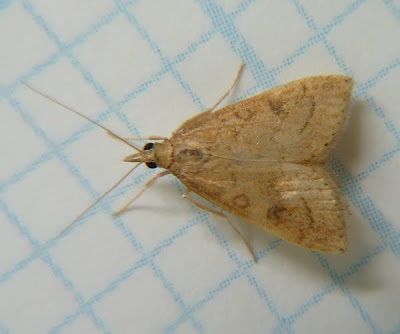The first is an Elegant Grass-veneer (Microcrambus elegans), a member of a distinctive subfamily of crambid moths. While members of the group can be difficult to identify, the group as a whole is easy to recognize because of their triangular shape, relatively long snouts, and similar banding patterns. Moths in this group fly low to the ground and are sometimes among the insects scattering from a grassy trail.
This Bluegrass Webworm Moth (Parapediasia teterrella) is in the same subfamily but is less boldly marked.
This crambid was a new species for me, a Spotted Peppergrass Moth (Eustixia pupula).
Another crambid was the Lucerne Moth (Nomophila nearctica), which I managed to catch with its wings unfurled.
This moth gave me some trouble because I was not able to find a close match among the various reference images. Eventually I settled on Speckled Rustic (Caradrina multifera). Even though this individual is darker than images at BugGuide, the shape and the other markings seem to match fairly well.
This moth is another noctuid, The Wedgling (Galgula partita). I previously found the red form of this species at the same location. The species is sexually dimorphic, with the lighter forms corresponding to males and the darker forms to females.
This moth appears to be a Common Eupithecia (Eupithecia miserulata), a geometer moth. Moths in this genus have distinctively long forewings held perpendicular to the body. I had some trouble identifying this individual because the Eupithecia moths look very similar to each other.
The last moth for this post is a Suzuki's Promolactis Moth (Promalactis suzukiella). According to BugGuide, this species has not been officially recognized in North America. The species was probably introduced from Asia, but more research is needed to determine whether the Asian and North American moths are the same species. All of the photos for this species on BugGuide come from four states on the East Coast: New Jersey, Pennsylvania, Maryland, and Virginia.

















































